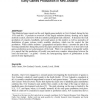60 search results - page 3 / 12 » Gaming on the edge: using seams in ubicomp games |
111
click to vote
CORR
2011
Springer
14 years 8 months ago
2011
Springer
In this paper, we study the average case complexity of the Unique Games problem. We propose a natural semi-random model, in which a unique game instance is generated in several st...
DIGRA
2005
Springer
15 years 6 months ago
2005
Springer
This illustrated paper reports on the early digital games industry in New Zealand, during the late 1970s and 80s. It presents an overview of this largely unknown history, drawing ...
133
click to vote
ICALP
2010
Springer
15 years 3 months ago
2010
Springer
We study bargaining games between suppliers and manufacturers in a network context. Agents wish to enter into contracts in order to generate surplus which then must be divided amon...
TCS
2008
15 years 1 months ago
2008
Given a graph G and an integer k, two players alternatively color the edges of G using k colors so that adjacent edges get different colors. The game chromatic index g(G) is the m...
125
click to vote
TCS
2008
15 years 1 months ago
2008
1 Elimination Game is a well known algorithm that simulates Gaussian elimination of matrices on graphs, and it computes a triangulation of the input graph. The number of fill edge...

